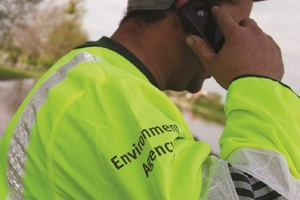International Paint spills banned chemical into conservation area
The company was found guilty despite denying charges that a banned chemical got into the Yealm estuary in Devon from its paint testing facility near Plymouth.

A man wearing a hard hat and a high-visibility jacket with the Environment Agency logo on his arm answers his mobile phone
International Paint Ltd, owned by multi-national AkzoNobel, appeared before Plymouth Crown Court on Thursday 27 October 2022, where, at the end of a nine-day hearing, it was found guilty on two charges.
The company denied both offences relating to the discharge of hazardous waste from a tank located on the quay at its Newton Ferrers paint testing facility.
The case is adjourned until January for sentencing.
The court heard that the Environment Agency launched an investigation after the company tried to sell the premises in 2015 and possible pollution was reported by Simon Friend of Red Earth Developments.
International Paint Ltd manufactured paints, including anti-fouling paints for ships, and had run a testing facility on the River Yealm at Newton Creek near Newton Ferrers since 1928. The estuary is a Special Area of Conservation due to its rich flora and fauna.
Since the 1970s, formulations containing tributyltin (TBT) had been used as a coating to prevent the build-up of organisms and plants on ships’ hulls. But it proved to be so toxic to the wider marine environment that it was banned from use on small vessels in the UK in the late 1980s and was banned completely worldwide during the 2000s.
One drop of TBT in an Olympic-sized swimming pool equals one part per trillion (PPT). The safe level of TBT is 0.2 PPTor a fifth of a drop.
The Environment Agency’s investigation found evidence that the chemical, along with copper, arsenic and mercury, had been present in sediment in the tank at the site and some of the sediment had escaped out into the estuary.
A bung on another tank was found to have come out leaving it open to the estuary, before it was eventually permanently sealed with concrete. The company denied having caused the discharge of the sediment into the estuary but did not answer what had happened to it.
Leading expert, Dr Michael Waldock, whose work led to the banning of TBT, carried out a review of sample analysis results from sediment from the tank and from the adjacent estuary for the Environment Agency. He found that nine out of 11 samples exceeded the safe limit for TBT and that, close to the site, one sample contained 80,000 times the safe level. He concluded that the TBT levels in the estuary were sufficient to have had a major toxic effect on marine life there.
James Wimpress of the Environment Agency said:
The company owned by a multi-national firm, and with a turnover of £134m in 2020, failed in its duty of care to the environment. The company denied any wrongdoing during the investigation and throughout the trial.
We are extremely pleased with the outcome and hope this serves as a warning to other companies that we will not hesitate to pursue those that act without regard to their responsibilities.
Background
-
Between 2 September 2015 and 27 October 2016, International Paint Ltd caused a water discharge activity otherwise than as authorised by an environmental permit, namely the discharge of hazardous waste sediments into the river Yealm estuary from the Quay Tank at 101 Yealm Road, Newton Ferrers. The said sediments being hazardous waste due to the presence of elevated levels of tributyltin (TBT), copper, mercury and arsenic, contrary to Regulations 12(1)(b) and 38 (1) of the Environmental Permitting (England and Wales) Regulations 2010.
-
Between 2 September 2015 and 27 October 2016, at 101 Yealm Road, Newton Ferrers, being a person who produces controlled waste, International Paint Ltd failed in its duty to take all such measures applicable to them in that capacity as were reasonable in the circumstances in that they failed to prevent the escape of waste, namely sediment containing elevated levels of tributyltin (TBT), copper, mercury and arsenic from their control, namely the Quay Tank at the above premises, contrary to section s 34(1)(b) and (6) of the Environmental Protection Act 1990, contrary to s.34(6) of the Environmental Protection Act 1990.